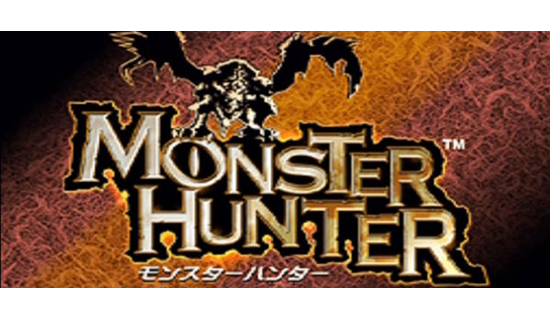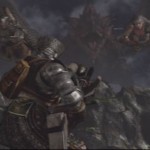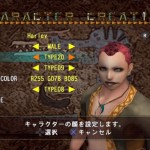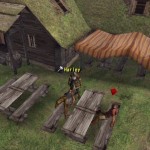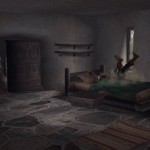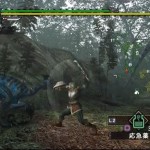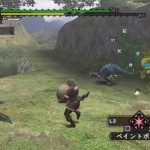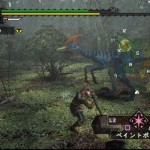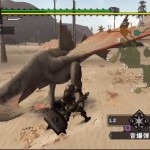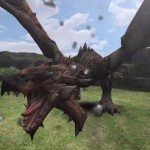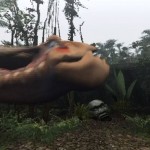There was a time (namely before the HD era of gaming) that big game companies like Capcom were not afraid to take a chance on new franchises. Taking heavy inspiration Sega’s Phantasy Star Online series as a base for its game play, it was in 2004 that the modern day Japanese gaming powerhouse began: the first entry in the Monster Hunter series was released. Though Capcom invented a brand new genre for this game called “Hunting Action”, it was similar to its predecessor in many ways, with just enough different twists to feel like a brand new experience. The basic flow of the game involves accepting specific quests from within a hub world, then setting out into separate areas to complete objectives for that quest. The difference is that in Monster Hunter you’re dropped into a prehistoric National Geographic Explorer where your opponents are dinosaurs, dragons, and other creatures that come right out of their natural environments. Though weapons and armor are constantly being upgraded throughout the game, in Monster Hunter there is an added sense of realism: It’s done using parts carved right from the carcasses of the monsters themselves.
Since there are a good number of different monsters to hunt throughout the game, there are also a good number of different weapons and armors to forge. Many sets of armor will give certain skills that will prove useful both in and out of battle, and many weapons will contain different types of elemental and status damage that can be used to your advantage against monsters with those weaknesses. There are a few different types of weapons to suit different styles of play: Sword and shield (the starting weapon, and for those who like to a speedy and combo heavy attack style), great sword (for those who prefer a slower but heavier damaging weapon, though it didn’t have the charge mechanic yet), hammer (if you want a weapon that’s heavier than sword and shield but not as heavy as great sword, and want a different feel than a bladed weapon. Also note that while it has the ability to charge, it doesn’t yet have the golf swing after two pounds), lance (if you want to be able to hide behind your shield and poke, or just love that 3 stab/evade combo), and light or heavy bow gun (you can attack from a distance, but these are really not good weapon choices in this particular installment). The western versions of this game actually featured the ability to create dual swords as well, though this feature would not come to the Japanese games until Monster Hunter G. The variety in weapons means that each monster battle requires a great deal of planning: Which armor set to wear, which weapon type to use (certain types are arguably more suited to specific monsters), and which element or status to use (if any).
Forging these weapons and armors are one of the many things you can do in Kokoto village, which acts as your hub world. In addition to accepting quests from the village elder and buying/upgrading weapons and armor, you can also buy some items (though you’ll primarily be gathering them when you’re out in the world), and just see what the other villagers have to say. Different levels of quests will unlock as you complete key quests in previous levels, allowing you to fight new and different monsters in new areas, and ultimately get better equipment. For those familiar with Phantasy Star Online, this is a very familiar game play loop. And like PSO, you’ll quickly loose interest if that loop isn’t satisfying to you in some way, since there’s very little story to be had here.
When fighting a monster, observing their patterns and behaviors is critical. This isn’t your typical action game, and you can’t start pounding it with your weapon and expect to win. In fact the ability to read a monster’s tells and know exactly what it’s going to do next is a point of pride for any good Monster Hunter player. You’ll also never see the monster’s health, and will only be able to tell when it’s weak once it starts limping away. Most monsters also have breakable and cutable parts on their bodies. Bladed weapons are able to cut off tails in some cases, and all weapons are able to break a part if it’s breakable in the first place. The act of doing so often results in the related monster parts as quest completion rewards. These elements give Monster Hunter a depth not found in any similar game before it. They also make fighting the monsters themselves incredibly fun. The feeling of encountering a new monster and having no idea what it’s going to do is both thrilling and stressful, making the discovery of its patterns all the more rewarding. Each monster feels like a living, breathing creature that’s full of personality, instead of just another enemy with a different AI.
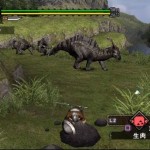 | 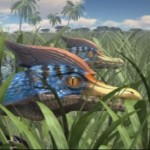 |
| Man, all the shit you have to go through to get anywhere in this game…Wait, I didn’t mean… | They should all be destroyed! |
There is one big drawback to be found here, and in fact in all console Monster Hunter games prior to Monster 3 on the Wii: The control scheme. The designers unfortunately thought that it was a good idea to have weapon actions controlled with the right analog stick: Instead of using the controller’s face buttons to swing a sword/hammer/lance or shoot a bow gun as you would do in later entries, the directional movements of the right analog stick are used. This means that the right analog stick is not controlling camera movement, as might expect. So how is camera movement controlled? Well with the D-Pad of course! This results in the player’s left hand being in a very awkward and uncomfortable position given the shape of a PS2 controller: Thumb on the left analog stick to move the character, with forefinger on the D-Pad to adjust the camera. With the optional middle finger on the L1 button reset the camera, it makes the player’s hand look like a withered claw (The name for holding the controller in this style is even nicknamed “the claw”). Even with this painful left hand configuration for managing character and camera movement, weapons could have still been controlled with the face buttons as they later would be.
But despite having one of the most obtuse control schemes ever, this first entry in the series was successful (though not even close to being the most successful in the series). This was undoubtedly due to all of the attention put into the general design and feeling of life that inhabits the game. “Leveling up” does not occur through stats that increment with battles fought, but rather with the increase in your own proficiency that comes with time and practice. This makes grinding monsters for parts used in the weapon and armor crafting system that much more bearable. It’s very repetitive due to the surprisingly low amount of quest rewards that you get after defeating each monster compared to later games in the series though. You can expect to fight a specific monster quite a few times if you want to create a full set of armor made from their parts. The individual areas in the game are not graphically mind blowing, but they do all have a life of their own. With each area being separated into individual and divided sections, not knowing exactly when a large monster may appear in front of you is one of the most interesting facets to how the area maps themselves were designed. Though the load screen that briefly appears during section transitions is a bit jarring at first, it becomes just another part of the game after awhile.
Both online and offline modes WERE available in Monster Hunter: Offline takes place in the previously mentioned Kokoto Village, whereas online takes place in a larger city called Minegarde. Once connected, a player could team up with up to 3 other players to take down monsters in online-mode specific quests. The monsters are largely as in the offline mode, with the big exceptions of a couple of elder dragons (they could only be fought online), most notably the huge lumbering Lao Shan Lung (who you have to fight much differently than any other monster). Players are forced to work as a team, each one playing a specific role dictated by their weapon choices, if they want to take down the monster. Though the objectives don’t change, it makes fighting monsters even more exciting than doing it all alone. It’s almost enough to make you wish that this game featured voice chat, but at least there was USB keyboard support. Minegarde was a fully functional city that also included a marketplace, armory, player housing and a tavern to accept quests with other players in. Playing online in Japan required a monthly fee, whereas the US and PAL versions were completely free. Unfortunately the servers were shut down on 06/30/2011 in Japan, and quite a bit earlier for the US and PAL versions of the game. This means that the online-only quests are no longer accessible by standard means.
There probably aren’t many who would recommend starting with the first game in the Monster Hunter series, myself included. I don’t have much nostalgia for these very early entries in the series myself, since it was slightly later ones that hooked me. And by then quite a few more quality of life improvements were introduced over what can be found here. This is one of those series where the best entry to start with is always the latest one. None the less, it set the foundations of everything that will make later entries in the series truly great, and gave those seeking a new mission-based gaming experience something fascinating.
